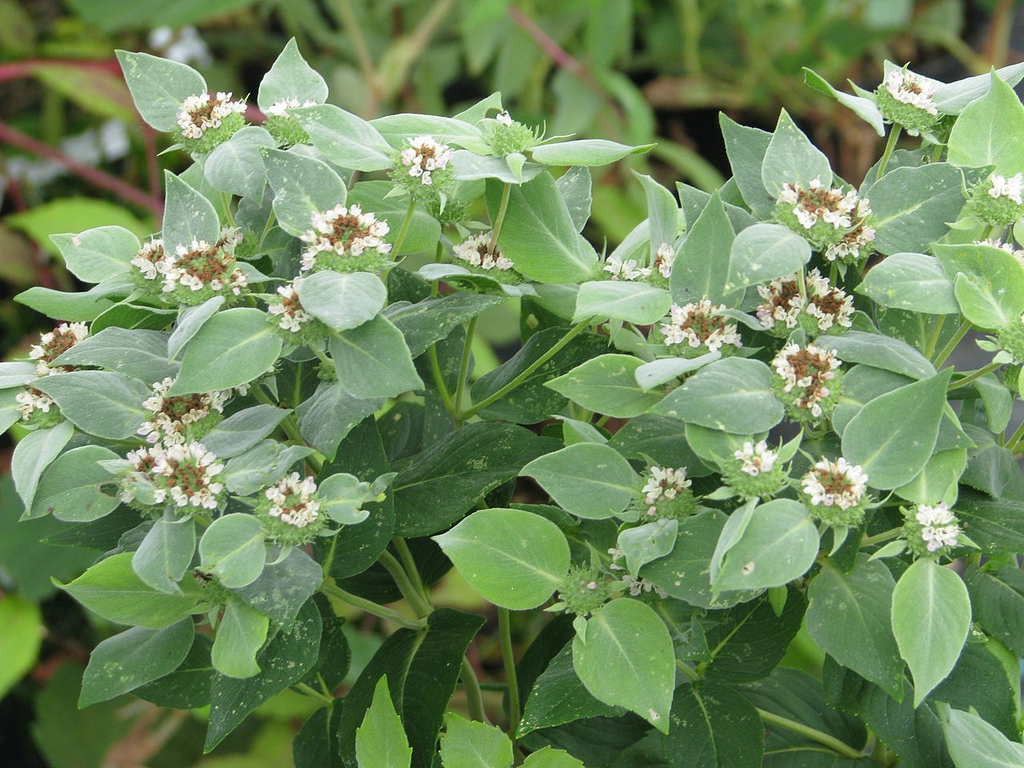Pycnanthemum muticum: Clustered Mountain Mint
Latin name: Pycnanthemum muticum
Common name: Clustered Mountain Mint
Flowers: Greenish-white with gray bracts mid to Late summer 4, 1/2" wide 12
Fruit or cones: Inconspicuous nut 4
Height & Width:18-36 in 4
Type: Herbaceous perennial 12
Habit: Spreading clump 12
Wetland indicator category**: 17
|
Atlantic and Gulf Coastal Plain |
FAC |
|
Eastern Mountains and Piedmont |
FAC |
|
Great Plains |
UPL |
|
Midwest |
FAC |
|
Northcentral & Northeast |
FAC |
Texture: Medium 12
Growth rate: Fast 12
Light: Full sun to part shade 12
Moisture: Average- moist 4
Soil*: Clay-sandy loam, neutral/slightly acidic PH 12
Zones: USDA Zones 4-8 12
Origin: Native L48 16
Ecosystem benefits: Food, nectar and pollen, larval food source12

Features: Smells like peppermint 4. The plant grows quickly and can grow in shallow soil with bright- partial sun depending on flower preference. Rabbits and deer avoid this plant because of the strong scent. Since this is an herb, it can be used in tea. Blooms 4-6 weeks with full sun 12.
Siting: Naturally found in sunny openings where the forest has been cleared or soil is shallow 12. Pycnanthemum muticum can grow in part shade, but it does not flower as well as full sun 12. Can be made to look like a bush for yards 12.
Care: Plant crown at soil level 18. At planting, water the roots and surrounding area slowly and deeply. Keep soil moist until plant is established, then apply enough water to thoroughly moisten the root zone when the soil is dry or during drought. Modify water recommendations to reflect site drainage and rainfall. Apply 3” of mulch over the planted area. Do not allow mulch to touch the plant stems 18.
Pests: Plants are relatively pest resistant if cultural preferences are met 12.
This plant does not appear on the following invasive plant lists on (9/24/2022):
- X USDA SC Invasive Plant Species Web site at http://www.invasivespeciesinfo.gov/plants/main.shtml
- X SC Exotic Plant Pest Council Web site at http://www.se-eppc.org/southcarolina/
Author: Chloe Aiello
Image source: NC State. “Pycnanthemum Muticum.” Pycnanthemum (Mountain Mint) | North Carolina Extension Gardener Plant Toolbox, 2022, https://plants.ces.ncsu.edu/plants/pycnanthemum/.
Sources:
- Armitage, A. (2001). Armitage’s manual of annuals, biennials, and half-hardy perennials. Portland, OR: Timber Press.
- Armitage, A. (2006). Armitage’s native plants for North American gardens. Portland, Oregon: Timber Press.
- Armitage, A. (2008). Herbaceous perennial plants: A treatise on their identification, culture, and garden attributes. Athens, GA: University of Georgia.
- Clemson Cooperative Extension Home and Garden Information Center.(2011). Flowers fact sheets. Retrieved from https://hgic.clemson.edu/category/flowers/
- Clemson Cooperative Extension Home and Garden Information Center.(2011). Groundcovers & vines fact sheets. Retrieved from https://hgic.clemson.edu/category/groundcovers/
- Clemson Cooperative Extension Home and Garden Information Center.(2011). Trees. Retrieved from https://hgic.clemson.edu/category/trees/
- Clemson Cooperative Extension Home and Garden Information Center.(2011). Shrubs. Retrieved from https://hgic.clemson.edu/category/shrubs/
- Dirr, M. A. (2009). Manual of woody landscape plants. Champaign, IL: Stipes Publishing.
- Gilman, E. F. (1997). Trees for urban and suburban landscapes. Albany, NY: Delmar Publishers.
- Lady Bird Johnson Wildflower Center University of Texas at Austin. (2012). Native plant information network. Retrieved from http://www.wildflower.org/explore/
- McMillan, P., Plant taxonomist Clemson University, personal communication.
- Missouri Botanical Garden Kemper Center for Home Gardening. Plant finder. Retrieved from http://www.mobot.org/gardeninghelp/plantfinder/Alpha.asp
- North Carolina State University (2005). Plant fact sheets. Retrieved from http://www.ces.ncsu.edu/depts/hort/consumer/factsheets/index.html
- Strother, E. V., Ham, D. L., Gilland, L. (2003) Urban tree species guide: Choosing the right tree for the right place. Columbia, SC: South Carolina Forestry Commission.
- University of Florida, IFAS Extension. (2011). Southern trees fact sheet. Retrieved from http://edis.ifas.ufl.edu/department_envhort-trees
- USDA . Plant profile. (n/d).Retrieved from http://plants.usda.gov/java/
- USDA. Plant wetland indicator status. (n/d). Retrieved from http://plants.usda.gov/wetland.html
- Vincent, E., Environmental horticulturist Clemson University, personal communication.
- Clemson Extension. Carolina Yards Plant Database. Retrieved from https://www.clemson.edu/extension/carolinayards/plant-database/index.htm
*Soil pH is determined using a professional soil test. Contact your Clemson University County Extension service for assistance www.clemson.edu/extension/. Click on “local offices”.
**2012 Plant Wetland Indicator categories (quantitative derived) http://plants.usda.gov/wetinfo.html
|
Indicator Code |
Indicator Status |
Comment |
|
OBL |
Obligate Wetland |
Almost always is a hydrophyte, rarely in uplands |
|
FACW |
Facultative Wetland |
Usually is a hydrophyte but occasionally found in uplands |
|
FAC |
Facultative |
Commonly occurs as either a hydrophyte or non-hydrophyte |
|
FACU |
Facultative Upland |
Occasionally is a hydrophyte but usually occurs in uplands |
|
UPL |
Obligate Upland |
Rarely is a hydrophyte, almost always in uplands |
